
A once-in-a-lifetime adventure in Quirimbas National Park, Mozambique


“You won’t believe its beauty,” I heard our pilot Chris say, crackling and popping into the headset, over the whirring and grinding of the helicopter blades as we rose beating into the air. I was relieved to be making a welcome retreat from the dry heat and dusty red-sand streets of Pemba, northern Mozambique. “Ho-hum”, I thought to myself, having seen my fair share of pretty, palm-lined Indian Ocean islands.
As my eyelids grew heavy and the warmth of the cockpit lulled me into a stupor, I overheard an excited gasp from a fellow passenger: “There’s a baby!”
Simultaneously, Chris banked to the side, and I had no choice but to open my eyes. What I saw below woke me in an instant: three humpback whales, gliding through the ocean, blowing puffs of air like popcorn. Mother and calf, and a third whale – the ever-present midwife and escort.
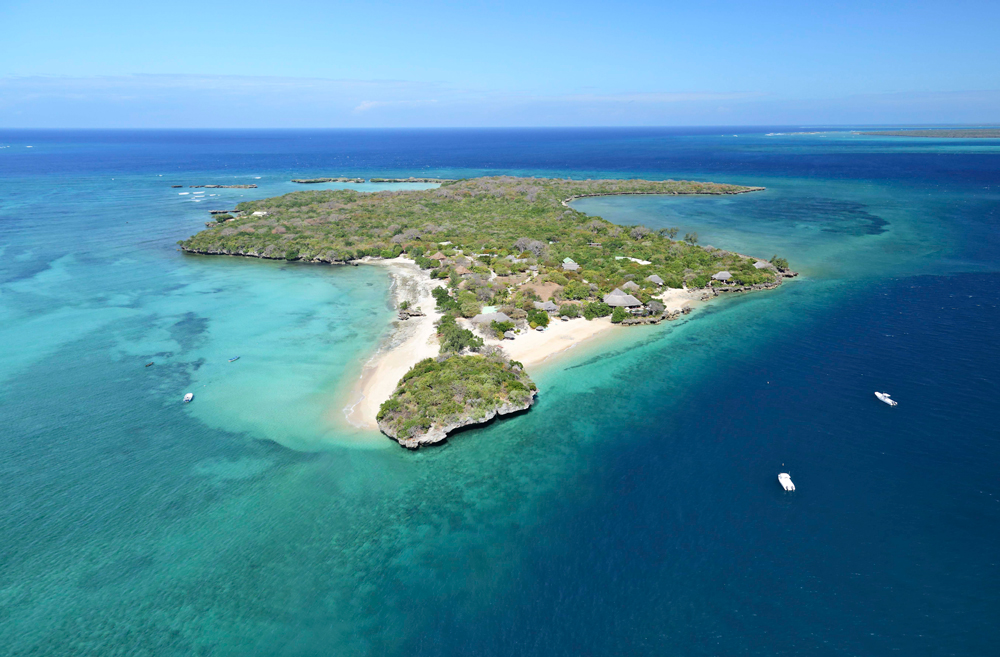
Further along, I saw another shoot of white water, a jet, blowing five to 10 metres into the air. As we approached, I saw that it was a line of blow-holes in the rock fringing an island. I was now completely wide awake. Instead of a snooze, as I thought it would be, it was a magical 30-minute flight northwards from Pemba, filled with whales, dolphins, baobab trees, mangrove swamps, reef-fringed islets, and dhows all intricately woven with the cleanest, bluest water I’ve ever seen.
The scene was now firmly set for four days of adventure on Quilalea, a tiny, uninhabited island, in the bluest of blue Indian Ocean that stretches 250 km northwards from Pemba to Palma.
Ocean adventures on the Quirimbas
From the moment the helicopter nudged the baobab-fringed helipad, to the moment my toes slipped into the azure soft, fringing ocean, to the moment I looked up and saw the bright blast of the Milky Way explode across the sky – or the moment the moons of Saturn bewitched me – I was in love with the Quirimbas and this 35 ha slice of paradise, Quilalea.
It felt like I had been dropped onto my own personal heaven. It was surreal and thrilling to think I had a whole island virtually to myself. I was taken back to my favourite childhood read, Arthur Ransome’s Swallows and Amazons, and I felt excited by the prospects for exploration that lay ahead.
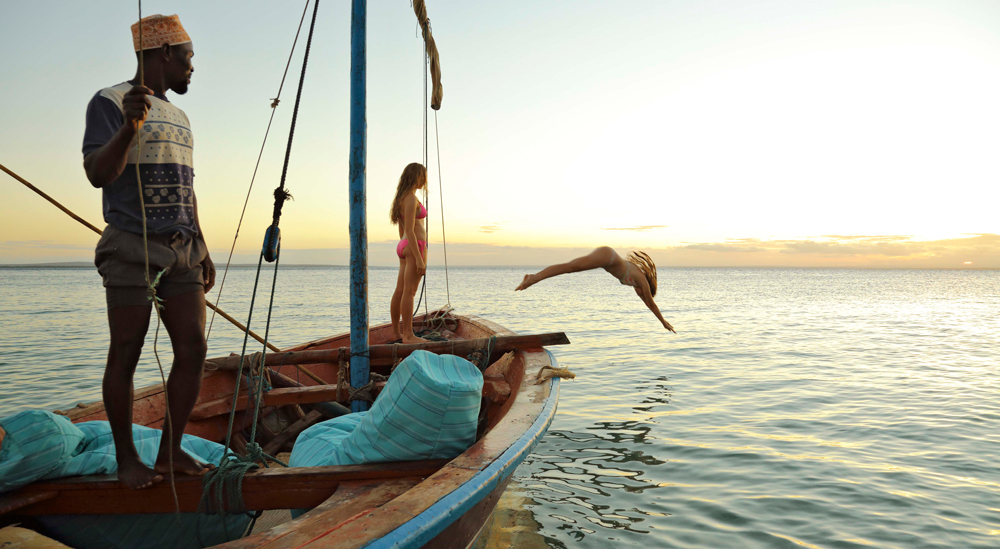
I found myself in a remote part of the Quirimbas National Park. Established in 2002, this managed and protected area spans 7,500 km² of north-eastern Mozambique. Of this, 20% covers marine habitats while the remainder is terrestrial, and 1,522 km² of the park is designated a Marine Protected Area (MPA), one of only six in Mozambique. In 2008, the entire archipelago was nominated to become a UNESCO World Heritage Site.
Mozambique, astoundingly, has a total marine estate of a whopping 571,493 km² and its marine protected area coverage is a measly 2.2% of that. For an area that the WWF has labelled “being of globally upstanding importance for marine biodiversity”, the protected portion, as beautiful as it is, seems wholly inadequate. With this in mind, when I realised that I was finally in a marine protected area, there was even more reason for me to be impassioned about being in the Quirimbas.
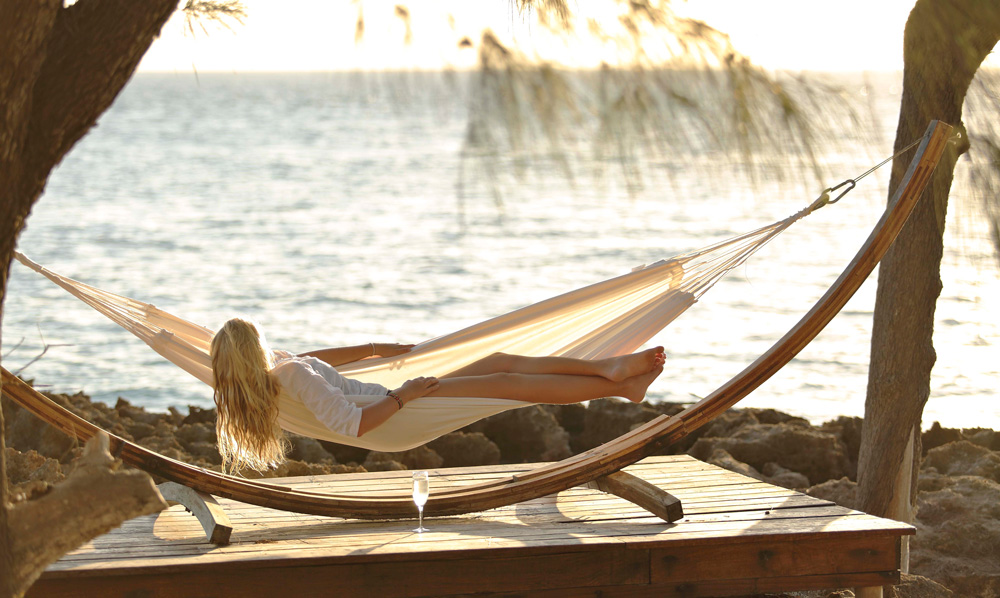
Exploring the waters of Quilalea
I was travelling with fellow adventurers, award-winning free-diver Hanli Prinsloo, extreme kitesurfer, Marcus Bull, and fellow underwater photographer, Peter Marshall. Not wanting to waste any time, we had decided on an afternoon ocean safari. As I unpacked, I heard squeals of delight coming from the ocean side of my plunge pool. On investigation, I discovered Hanli and Peter already in the water enjoying a snorkel amongst the volcanic structures.

As I heard them pointing out rays and hunting fish to each other, I felt excited about the afternoon trip. Although I was tempted to relax on the gently swaying hammock outside my villa, I gathered my camera and swimsuit for the afternoon outing.
Whizzing around the island on the speedboat, I could see a pearl-white beach, waves frilling over the shallow reef. Quilalea is one of the 11 islands within the Quirimbas National Park. The sandy beaches are used as breeding sites by hawksbill, green and olive ridley turtles. Loggerhead and leatherback turtles are also present in these waters – as are several other ocean species that the IUCN lists as endangered. Some are resident and others migratory, but here there are regular sightings of dugong, great white sharks and whale sharks.
I was anxious to find another two species I’d heard we might see in this marine life haven. After a short search, we saw the first: a small pod of humpback whales, travelling in three as they so often do. I felt some of my anxiety slip away when we spotted a school of bottlenose dolphins and quickly put on our snorkelling gear. As I looked down, I could see the coral ‘bommies’ and a wave of anticipation washed over me.

Seeing dolphins underwater in their natural environment is a treat, and I knew the thrill that was coming. We dived off the boat, and within seconds the mystical, magical creatures approached, squinting sideways at our relative ungainliness. Moments with dolphins are hard to forget, and in this blue water, I added a memory to my bank and left the water happy and laughing.
We saw a massive flock of sooty terns darting into the cresting waves, chasing food. On closer inspection, a school of tiny silver baitfish was worth investigating as we saw them jumping out of the water to escape the hungry jaws of tuna. We dived in and looking down into the intense blue, I saw a squadron of at least five grey nurse sharks, reflected rays of sunlight straddling their grey backs. They came up to the 10-metre depth to look at us curiously and then slipped silently off, back to hunt tuna. I was impressed and encouraged that on this short trip, we had seen such a wide variety of marine life.
Back on the boat heading back to the hotel, hungry and happily-exhausted, our guide Predi delighted me further when she told me that I could look forward to the following morning’s scuba dive. There were hunting jacks, potato bass and tiny bubble shrimps on the ‘house reef’ here. I was intrigued.
Diving the house reef
I’d previously had the pleasure of walking a few steps from a hotel onto a reef so full of life, but far away, in Indonesia. I felt enormously privileged when Predi explained this was the only place in Mozambique with a ‘walk-in’ house reef. However, it was when she told me about the Napoleon wrasse, that Predi had me proverbially hooked. These inquisitive fish are a personal favourite, and I wasn’t sure I’d be able to sleep that night, for the waves of excitement I felt at the prospect of seeing them again.
That night, we ate dinner out on the warm beach. There was a sumptuous selection of food, and candles, stars and fine wine surrounded us. The next morning couldn’t come soon enough for me, and I joined Predi on the magnificent house reef. I walked right off the beach in front of the hotel and dropped bubbling down above huge, heads of coral spanning two to three metres and teeming with rainbow-coloured jewels.

The dive was a drifting one, as the current spun us towards the open ocean and the hard corals soon gave way to splendid soft corals in bright reds, pinks and oranges. I saw giant anemones sheltering clownfish, and hunting lionfish, red and pouting, hanging over clouds of silver glassies. I spotted at least four turtles crunching on the reef, but as they heard our bubbles, they winged their way over the reef and out of sight.
The offshore reefs of the national park support a huge array of marine wildlife, including 52 coral species and 375 fish species. There are several different scuba dives a short boat trip away from Quilalea, but unfortunately, time didn’t allow for me to do any other than two on the house reefs.
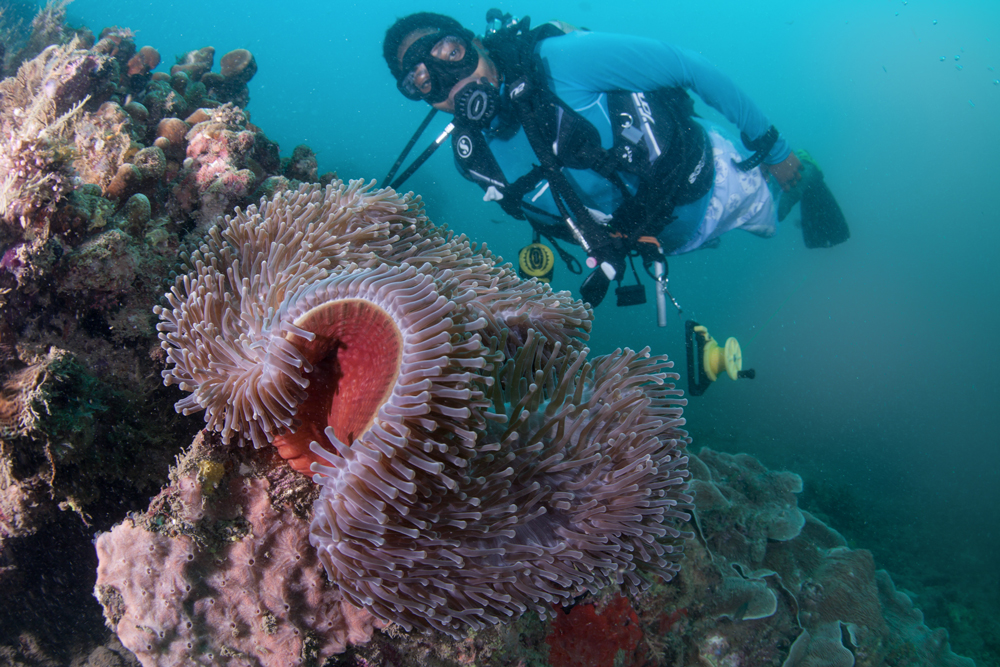
Mangroves and marine magic
That afternoon we went on a kayaking trip over to nearby Seneca Island, which is also uninhabited unless you count the numerous mangrove crabs and mudskippers, or the birds such as herons, mangrove kingfishers or eagles that fish there. The seawater winds its way through the centre, from one side of the island through a tangled web of healthy huge mangroves out to the open ocean on the far side. As I paddled lazily between the mangrove trees, I heard the thundering of the breakers hitting the coral reef beyond the ‘coral rag’ rock wall.

I collected some seagrass that was floating on the surface of the water as we paddled. Perched on top of this grass, on their way to new homes, were hundreds of juvenile frogfish the size of peas. I was awash with pure delight – this find was the highlight of my time in the archipelago. It was a sign of the incredible life force and power of the ocean.

Dinner that night was a seafood banquet in the middle of a romantically lit baobab copse. I was looking forward to the following day, which was to be purely allocated to exploration and adventure.
As soon as we could, Hanli, Peter and I set off at low tide to walk over the sandy water-carved bars between the fringing coral reefs.
The substrate of the islands in this archipelago is composed of rag-coral and sand that has become bonded into a brittle, yet razor-sharp pockmarked rock. We watched mantis shrimp and golden eels jumping and hunting in the shallow 10cm of water and saw pink, green and purple parrotfish chomping at the shallow reefs. I was relieved to see scores of leopard cowries littering the weedy exposed reefs, striped golden mantles out, lying in wait, just like their cat namesakes.
I hadn’t seen so many live cowries since I was a child playing in the coral reefs of Mombasa, Kenya. We climbed intricate rock formations and scuttling crabs peered warily at us, with red and green pop-eyes. The rising water pushed us back onto the island. Before our post-exploration hunger pains got too intense, we opted for a spot of baobab clambering. I found that the solid, silver smoothness of a lofty baobab trunk also makes it impossible not to hug their bulging midriffs.

A late goodbye
The Quirimbas has adventure in store for everyone – from the person looking to relax and read in the sun, the spa lover, the outward-bound adventurer and the foodie traveller. A day trip from Quilalea to haunting Ibo Island will provide a chance to explore the stone walls of this ancient settlement, and even buy intricately hand-beaten silver jewellery from one of the silversmiths living there. Ancient palaces and villas lie littered and layered in moss – a photographer’s dream world.
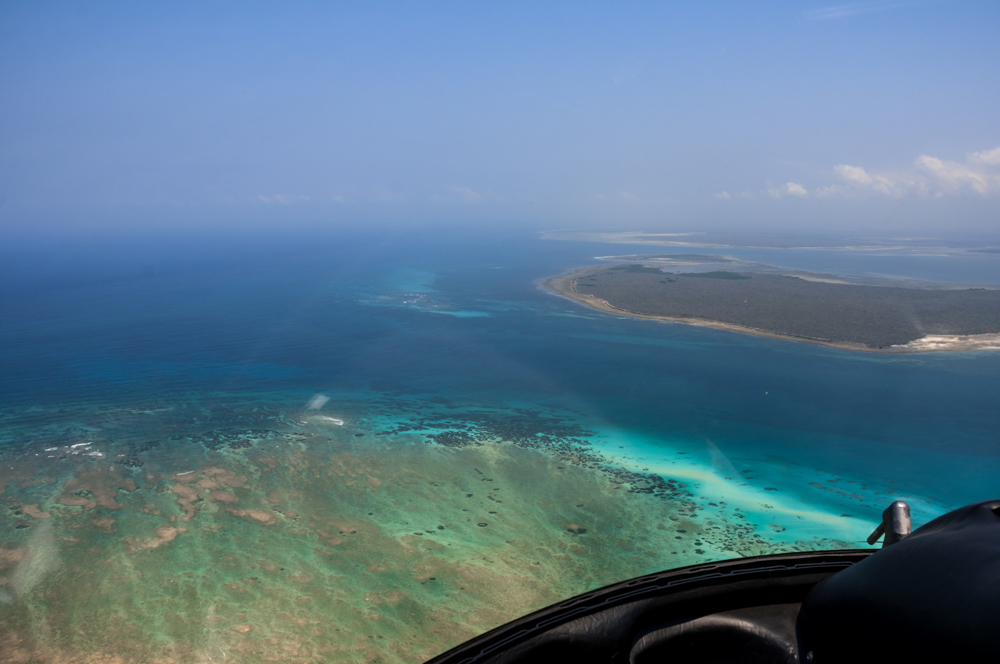
On the final morning, we enjoyed a champagne breakfast picnic on the beach before our farewell, and as I had been baulking at leaving, I was late! As I hurriedly followed my bags back to the helicopter, I heard delighted giggles. I turned and jealously yelped a hasty farewell to Hanli and Peter as I glanced reluctantly sideways at them, snorkelling in the pristine shallows below the main pool deck. They were just where I wanted to be. I grinned, holding my tongue, my eyes wide shut, as Hanli shouted back: “There’s a huge reef down here buzzing with life. You won’t believe its beauty”.
This time, I did.

Life on Quilalea island
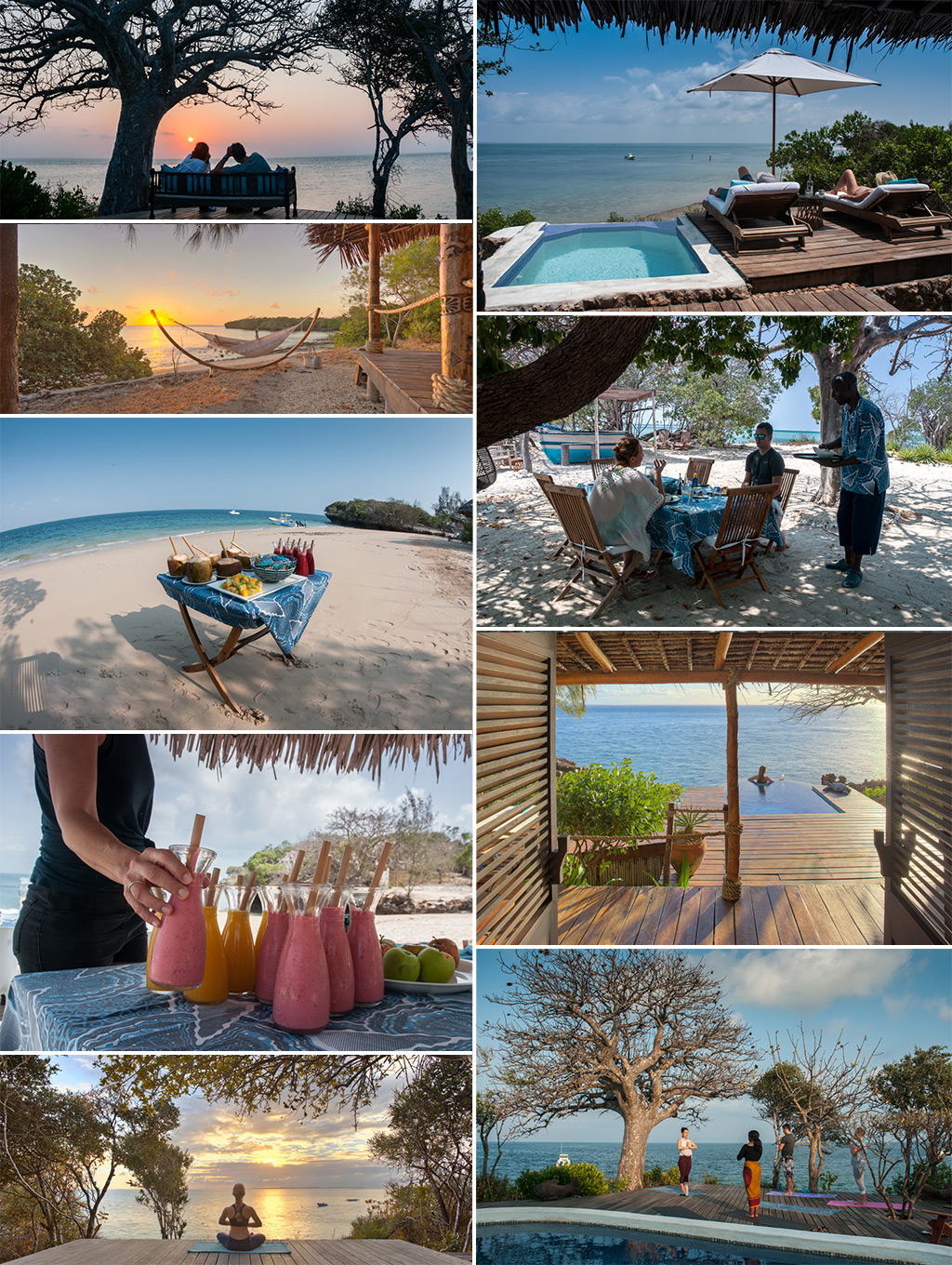
Quirimbas National Park info
The Quirimbas National Park is the largest marine protected area in Africa, located in the Cabo Delgado Province in the far northeast corner of Mozambique.
Established in 2002, the park covers coastal forest habitats, miombo woodland, granite inselbergs, mangrove stands, and coral rock islands. It includes some 7,500 km² (750,600 hectares) and stretches along 110 km of coastline on the Indian Ocean. The eleven most southerly islands from the Quirimbas Archipelago make up part of this national park, including Quilalea Island.
In total, there are over 30 tropical islands in the Quirimbas Archipelago that stretch approximately 250 km along the coast from the city of Pemba to the northern border of Mozambique, where it meets Tanzania.
History
An Arab trading post since 600 AD, the Portuguese didn’t even set foot on the Quirimbas islands until Vasco de Gama rested here in 1500. In the coming years, hostilities broke out between the Portuguese and Arab people over trading rights. After successfully razing the Arab fortifications in 1522, the Portuguese had assimilated the islands entirely by 1590.
Ibo Island then became the second most crucial Portuguese trading post after Ilha de Mocambique and would become the capital of the region known as Cabo Delgado. In 1902, the provincial capital of Cabo Delgado was transferred to what is now known as Pemba, leading to the gradual decline of trade and population in the islands.
People
Quirimbas National Park is unique in that it was created in response to requests from local communities and other stakeholders who wanted to resolve the myriad of problems that beset the Province of Cabo Delgado in general and the Quirimbas area in particular.
Approximately 55,000 people live in or around the park, and nearly all of these inhabitants rely directly on the Quirimbas resource base for their livelihoods. To date, local communities have been involved in all aspects of the development of the park, from the conceptualisation of the original idea through to planning, mobilisation, and implementation of initial management strategies.

Marine life
The park contains a wide variety of protected marine life including green, hawksbill and olive ridley turtles. Other protected species include humpback whales, the endangered humpback dolphins, sea horses and pipefish.
Seasons
Like the rest of the northern Mozambique coastline, the Quirimbas islands are subject to a humid equatorial climate and experience only two distinct seasons: a wet season and a dry season. The majority of rainfall occurs between December and April, with the rest of the year being cooler, dry, and sunny. Daytime temperatures vary from around 25°C (77°F) to 35°C (95°F), depending on the time of year. Water temperatures range from 24°C (75°F) to 27°C (81°F).
Azura Quilalea
For accommodation options at the best prices visit our collection of camps and lodges: private travel & conservation club. If you are not yet a member, see how to JOIN below this story.

Azura Quilalea Private Island is the perfect place to escape the hustle and bustle of daily life, in a remote, pristine corner of Mozambique’s spectacular marine wilderness. Here, you can snorkel the island’s shores, dive the reef from the main beach, kayak amongst the mangrove swamps or relax in a hammock beneath the giant baobabs on the island. This is the ultimate private luxury hideaway, in a stunning and undiscovered destination – an untouched paradise for the adventurous traveller to discover.

About the author
 Fiona Ayerst is a freelance adventure-sport and underwater stills photographer and journalist with a particular interest in sharks. She turned professional in April 2006 after practising as an attorney for twelve years – and hasn’t looked back since. She travels the world extensively and writes about adventure travel and conservation for various local and international publications. She also teaches underwater photography and runs specialist workshops for digital photographers on multiple locations around the east coast of Africa.
Fiona Ayerst is a freelance adventure-sport and underwater stills photographer and journalist with a particular interest in sharks. She turned professional in April 2006 after practising as an attorney for twelve years – and hasn’t looked back since. She travels the world extensively and writes about adventure travel and conservation for various local and international publications. She also teaches underwater photography and runs specialist workshops for digital photographers on multiple locations around the east coast of Africa.
To comment on this story: Login (or sign up) to our app here - it's a troll-free safe place 🙂.![]()






